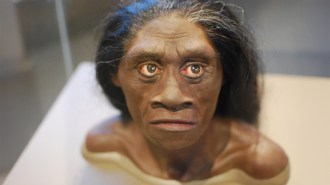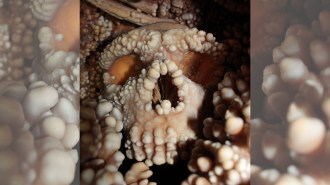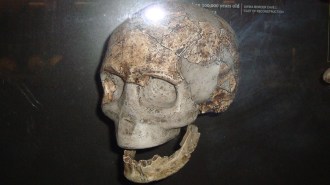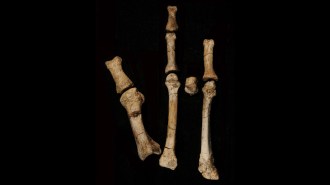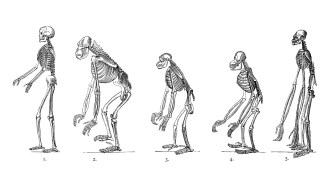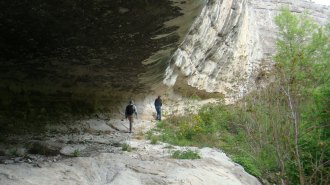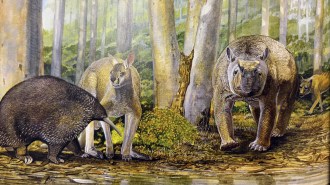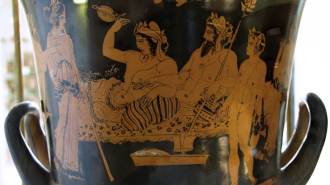Ancient footprints yield oldest signs of upright gait
Human ancestors may have been walking with an efficient, extended-leg technique by 3.6 million years ago
Despite a penchant for hanging out in trees, human ancestors living 3.6 million years ago in what’s now Tanzania extended their legs to stride much like people today do, a new study finds. If so, walking may have evolved in leaps and bounds, rather than gradually, among ancient hominids.
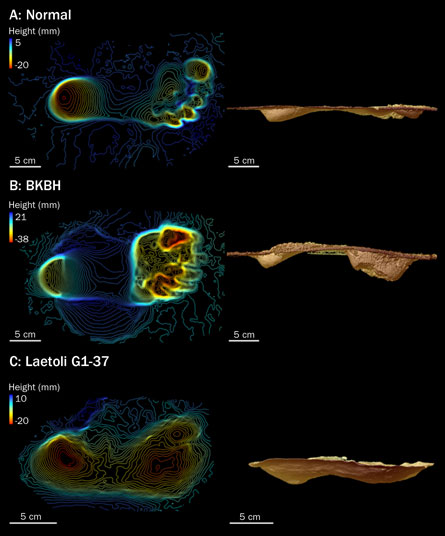
The discovery comes from the famed trackway site in Laetoli, Tanzania, where more than 30 years ago researchers discovered footprint trails from two, and possibly three, human ancestors who had walked across a wet field of volcanic ash. The new analysis shows that the Laetoli hominids made equally deep heel and toe impressions while walking across a soft surface, say anthropologist David Raichlen of the University of Arizona in Tucson and his colleagues.
That pattern is a cardinal sign of a humanlike gait, and suggests that an energetically efficient, extended-leg stride appeared surprisingly early in hominid evolution, Raichlen’s team proposes in a paper published online March 22 in PLoS ONE. Until now, many researchers suspected that such a gait did not appear at least until the appearance of early Homo species around 2.5 million years ago.
“By the time hominids walked through the ash at Laetoli, they walked more like us than like apes,” Raichlen says.
Many anthropologists attribute the Laetoli prints to Australopithecus afarensis, the species that includes the partial skeleton dubbed Lucy.
Some researchers previously argued that the Laetoli footprints resulted from a humanlike gait. Others have seen signs of a bent-knee, bent-hip stride characteristic of modern chimpanzees. The new investigation challenges that view.
“Raichlen’s data are persuasive but admittedly limited in focus,” remarks anthropologist William Jungers of Stony Brook University Medical Center in New York. Lucy’s species differed from modern humans in ways that might have created gait disparities, in his view. Still, heel and toe depths at Laetoli provide a glimpse of efficient walking “long before the emergence of our own genus, Homo,” Jungers says.
Raichlen’s group is the first to analyze the Laetoli footprints from a biomechanical perspective. Eight adult volunteers walked twice across a lightly moistened sand walkway meant to reproduce the conditions in which the Laetoli prints formed. They then walked twice across the same sand surface while assuming a crouched stance. Special motion tracking and scanning equipment calculated the degree to which each person’s hips and knees bent during all trials and generated three-dimensional models of participants’ footprints.
People walking with an erect gait produced footprints with nearly equal heel and toe depths, the team found. In contrast, a crouched stride yielded markedly deeper toe impressions than heel impressions, reflecting faster weight transfer over the length of the foot.
To Raichlen’s surprise, previous calculations of Laetoli footprint depths closely matched the even heel and toe depths left by people walking in their usual fashion.
A. afarensis fossils display an inwardly curved lower back, pronounced foot arches and other traits consistent with Raichlen’s evidence for a humanlike gait at Laetoli, comments anthropologist Carol Ward of the University of Missouri in Columbia. “Any energy inefficiencies in walking relative to later Homo would have come from a small body size and wide body breadth, nothing more,” she says.
No one knows precisely how hominids before Lucy’s time walked. Ardipithecus ramidus, known primarily from a 4.4-million-year-old partial skeleton (SN: 1/16/10, p. 22) did not walk like people today, but the nature of its gait is unclear, he says.
“I doubt that the case is closed on debate over what gait was like in australopithecines, but this new study has made important strides in that direction,” says anthropologist Brian Richmond of George Washington University in Washington, D.C.
